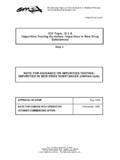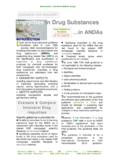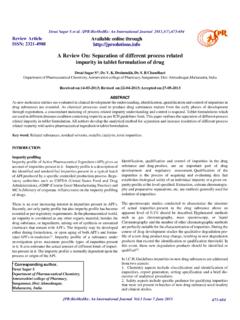Transcription of FDA Perspectives: Common Deficiencies in …
1 FDA Perspectives: Common Deficiencies in Abbreviated New Drug Applications: Part 1: Drug Substance Team leaders in FDA's Office of Generic Drugs provide an overview of Common Deficiencies cited throughout the CMC section of abbreviated new drug applications. Jan 2, 2010 By: Aloka Srinivasan, Robert Iser Pharmaceutical Technology Volume 34, Issue 1, pp. 50-59 The ever increasing workload at the Office of Generic Drugs (OGD) within the US Food and Drug Administration's Center for Drug Evaluation and Research (CDER) has led the office to develop a number of strategies to streamline the review process. One such strategy was the introduction of Question-Based Review Quality Overall Summary (QbR QOS).
2 Another strategy involves asking sponsors of abbreviated new drug applications (ANDAs) to provide a Pharmaceutical Development Report with their application. The QbR is a platform for implementation of CDER's Pharmaceutical CGMPs for the 21st Century: A Risk-Based Approach and a springboard to quality by design (QbD). It also provides the sponsors with an opportunity to discuss the development of their product. The summary report in QbR-QOS can be referenced by the reviewers as a snapshot of the ANDA before they review the entire application ( , the body of data). Adequate information provided in the QbR QOS and the Pharmaceutical Development Report reduces the application assessment time, minimizes transcriptional errors, and helps the review process at all levels (primary, secondary, and tertiary).
3 Examples of commonly cited drug-substance related Deficiencies in ANDAs (as paraphrased by the authors) Also, by seeking sponsors' responses to critical questions regarding the quality of their drug product, the QbR has helped to reduce the number of Deficiencies cited for an application. This process of knowledge sharing has improved the overall review quality. However, it has not met the expectation of the Office of Generic Drugs (OGD) because applications are being submitted with minimal justification in establishing product quality. Despite OGD's efforts, the number of amendments submitted in response to FDA's deficiency letters, have still been staggering.
4 With this as prologue, a series of articles are forthcoming in an effort to be more transparent and to assist sponsors to submit applications with adequate justification for drug substance and drug product (DS and DP) specifications, in-process controls, choice of formulation, product design, and manufacturing processes. Our experience shows that having justification in the original submission reduces the number of Deficiencies and provides assurance to the agency in the sponsors' ability to manufacture high quality drug products. These articles will attempt to clarify the intent and criticality of some of the Common Deficiencies cited throughout the Chemistry, Manufacturing, and Controls (CMC) portion of ANDA submissions.
5 Sponsors may use this information to build quality into their submissions. As background for this work, the authors have surveyed a representative sample of deficiency letters issued by each chemistry team within OGD over the past six months. The surveyed Deficiencies were cited for ANDAs submitted in the QbR QOS format. However, this article is not intended to be a discussion of all Common Deficiencies in ANDAs. The article focuses exclusively on the drug substance portions of the ANDA submissions using the Common Technical Document (CTD) and QbR format as a guide. For a partial list of some Common drug substance related Deficiencies , see the sidebar "Examples of commonly cited drug-substance related Deficiencies .
6 " One area that will not be expanded on in this article is the Common deficiency that the referenced Drug Master File (DMF) is inadequate and, as such, the ANDA sponsor should not respond until they have been informed that the DMF Deficiencies have been addressed. The deficiency in itself is rather clear and its criticality is obvious as the drug substance is the key ingredient in the product. However a recommendation to ANDA sponsors is that they "do their homework" when selecting a DMF partner and be aware of the information available to them with regard to drug-substance characterization, properties, purity, and methodology as well as the regulatory history of the DMF holder.
7 The upcoming International Conference on Harmonization (ICH) Q11 guideline on drug substances should provide clarity for both DMF holders and ANDA sponsors with respect to the critical aspects of the drug substance. Schwartz provides another helpful resource with respect to critical information to be gleaned from the referenced DMF (1). A second topic not discussed in this article is the issue of polymorphism. It is again a frequently cited deficiency where the ANDA sponsor has been requested to include information and a control for polymorphic identity and its impact on the performance of the drug product.
8 The sponsors are highly recommended to address criticality of controls of polymorphism in the drug substance and/or the drug product based on an evaluation of drug substance characteristics, proposed formulation, proposed manufacturing process, and its impact on the product performance. For more details on the significance of polymorphism in ANDAs, please refer to the following publications (2, 3). / Drug Substance General Information1 . The second question in the QbR QOS pertains to drug-substance properties. This question is inconsistently answered by the sponsors of most applications. A full understanding of the drug-substance properties is essential in the development of formulation, manufacturing process, analytical methodology, and product stability.
9 In many instances, this critical information is lacking and triggers a question requesting the identification of crucial aspects of the drug substance that are essential in making a quality drug product. An understanding of the drug-substance properties is paramount to ascertaining the critical material attributes (CMA). The properties may or may not be CMAs based on the intended use or performance, the formulation, manufacturing process, analytical methodology, and product stability. Examples are as follows: Solubility may be critical to determining the formulation, the process, and the performance of the product.
10 A study of pH- related solubility and solubility in various organic solvents can also be used to justify manufacturing process steps and in providing information useful for developing suitable analytical methods. Knowledge of hygroscopicity may have an impact on choices made in the formulation or the manufacturing process; and may also provide insight into potential stability challenges if the drug substance or the formulation is sensitive to moisture. Providing an answer to this question and identifying the drug-substance aspects that are critical to product quality can eliminate this request coming from the reviewer.




